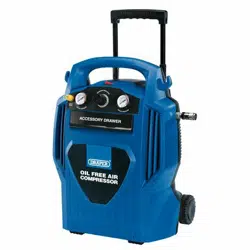Loading ...
Loading ...
Loading ...

5. HEALTH & SAFETY INFORMATION 10. TROUBLESHOOTING
15
6
Compressor will not
run.
1. No electrical power.
2. Blown fuse.
3. Breaker open.
4. Thermal overload open.
5. Pressure switch bad.
1. Plugged in? Check fuse/breaker or
motor overload.
2. Replace blown fuse.
3. Reset, determine cause of problem.
4. Motor will restart when cool.
5. Service/repair/replace.
Motor operating,
but cannot run or
runs slowly.
1. Defective check valve or
unloaded.
2. Poor contacts, line
voltage low.
3. Shortened or open motor
winding.
1. Service/repair/replace.
2. Check circuit with voltmeter.
3. Service/repair/replace.
Tank pressure drops
when compressor
shuts off.
1. Check valve leaking.
2. Loose connections at
pressure switch or
regulator.
1. Service/repair/replace.
2. Service/repair/replace.
Fuses blow/circuit
breaker trips
repeatedly.
Caution! Never use
an extension cord
with this product.
1. Incorrect size fuse, circuit
overloaded.
2. Defective check valve or
unloaded.
1. Check for proper fuse, use
time-delay fuse. Disconnect other
electrical appliances from circuit or
operate compressor on its own
branch circuit.
2. Service/repair/replace.
Thermal overload
protector cuts out
repeatedly.
1. Lack of proper
ventilation/room
temperature too high.
2. Compressor valves failed.
3. Low voltage.
1. Move compressor to well
ventilated area.
2. Service/repair/replace.
3. Check circuit with voltmeter.
Knocks, rattles,
excessive vibration.
1. Cylinder or piston ring is
worn or scored.
1. Service/repair/replace.
Compressor runs
continuously and air
output is lower than
normal/low
discharge pressure.
1. Excessive air usage,
compressor too small.
2. Clogged intake filter.
3. Air leaks in piping (on
machine or in outside
system).
4. Broken inlet valves.
5. Piston ring worn.
1. Decrease usage or purchase unit
with higher air delivery (SCFM).
2. Service or replace.
3. Replace leaking components or
tighten as necessary.
4. Service/repair/replace.
5. Service/repair/replace.
Have this tool repaired by a qualified person. This tool is designed to confirm to the
relevant international and local standards and as such should be maintained and repaired
by someone qualified, using only original parts supplied by the manufacturer. This will
ensure the tool remains safe to use.
5.1 GENERAL SAFETY INSTRUCTIONS FOR POWER TOOL USE
Warning: Read all safety warnings and all instructions. Failure to follow the warnings and
instructions may result in electric shock, fire and/or serious injury.
Save all warnings and instructions for future reference.
The term “power tool” in the warnings refers to your mains operated (corded) power tool or
battery-operated (cordless) power tool.
1) Work area safety
a) Keep work area clean and well lit. Cluttered or dark areas invite accidents.
b) Do not operate power tools in explosive atmospheres, such as in the presence flammable
liquids, gases or dust. Power tools create sparks which may ignite the dust or fumes.
c) Keep children and bystanders away while operating a power tool. Distractions can cause
you to lose control.
2) Electrical safety
a) Power tool plugs must match the outlet. Never modify the plug in any way. Do not use any
adapter plugs with earthed (grounded) power tools. Unmodified plugs and matching outlets
will reduce risk of electric shock.
b) Avoid body contact with earthed or grounded surfaces such as pipes, radiators, ranges and
refrigerators. There is an increased risk of electric shock if your body is earthed or grounded.
c) Do not expose power tools to rain or wet conditions. Water entering a power tool will
increase the risk of electric shock.
d) Do not abuse the cord. Never use the cord for carrying, pulling or unplugging the power
tool. Keep cord away from heat, oil, sharp edges or moving parts. Damaged or entangled
cords increase the risk of electric shock.
e) When operating a power tool outdoors, use an extension cord suitable for outdoor use. Use
of a cord suitable for outdoor use reduces the risk of electric shock.
f) If operating a power tool in a damp location is unavoidable, use a residual current device
(RCD) protected supply. Use of an RCD reduces the risk of electric shock.
3) Personal safety
a) Stay alert, watch what you are doing and use common sense when operating a power
tool. Do not use a power tool while you are tired or under the influence of drugs, alcohol
or medication. A moment of inattention while operating power tools may result in serious
personal injury.
b) Use personal protective equipment. Always wear eye protection. Protective equipment
such as dust mask, non-skid safety shoes, hard hat, or hearing protection used for
appropriate conditions will reduce personal injuries.
c) Prevent unintentional starting. Ensure the switch is in the off position before connecting
to power source and/or battery pack, picking up or carrying the tool. Carrying power
tools with your finger on the switch or energising power tools that have the switch on
invites accidents.
d) Remove any adjusting key or wrench before turning the power tool on. A wrench or a
key left attached to a rotating part of the power tool may result in personal injury.
10.1 TROUBLESHOOTING GUIDE
Loading ...
Loading ...
Loading ...
